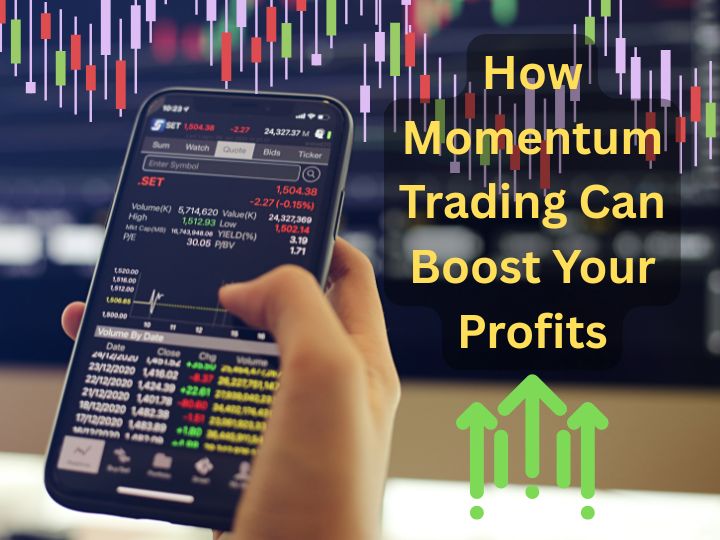In the high-octane world of trading, timing is everything. For many ambitious traders, momentum trading has become a powerful and dynamic approach to capitalize on fast-moving trends in the stock market. If you’ve ever wondered how traders manage to jump into a stock just as it starts moving and ride it for quick profits — welcome to the thrilling universe of momentum trading.
At Stock Market Vidya, Nagpur’s trusted name in stock market training, we teach our students how to spot momentum, how to read the pulse of the market, and how to stay ahead of the curve. Let’s dive deep into the strategy that helps thousands ride the market waves — with confidence, precision, and discipline.
What is Momentum Trading?
Momentum trading is like surfing the stock market. You ride the wave of price movement — upward or downward — for as long as it lasts. The idea is simple: stocks that are rising tend to continue rising, and those that are falling tend to continue falling — until the momentum fades.
Rather than focusing on fundamentals, momentum traders look at price action, volume, trends, and speed. The goal is not to invest in a stock for the long term, but to profit from short to medium-term moves by entering at the right time and exiting before the trend reverses.
The Psychology Behind Momentum Trading
Momentum trading is not just about charts — it’s about human behaviour. Markets move based on investor sentiment, news, fear, and greed. When everyone starts chasing the same stock, the price rises rapidly. That’s momentum in action.
Momentum traders tap into this psychology. They understand the crowd’s reaction, follow the flow, and use technical tools to time their entries and exits. The key is discipline — to avoid chasing blindly and to ride the wave with a plan.
Core Principles of Momentum Trading
Let’s break down the essential principles that drive successful momentum trading:
1. Trend is Your Best Friend
Momentum traders always follow the trend — not fight it. If a stock is breaking out with strong volume, they go with the flow. It’s all about being in sync with market direction.
2. Volume Validates the Move
High volume confirms that many participants are entering the trade. It adds strength to the trend. Without volume, price moves may be weak or unreliable.
3. Entry Timing is Everything
Momentum traders often use intraday or daily charts to find breakouts or breakdowns. The goal is to enter when momentum is just starting, not when the move is already overextended.
4. Quick Reaction, Not Impulse
Momentum trading requires swift decision-making, but not impulsiveness. It’s about acting fast — based on analysis, not emotion.
5. Defined Exit Strategy
Every momentum trade must have a clear exit point — either for profit or loss. The market can turn quickly, and without a plan, gains can vanish in seconds.
Indicators That Guide Momentum Traders
Successful momentum traders use technical tools to help identify trading opportunities. Here are some of the most popular:
Moving Averages (MA)
Short-term moving averages like the 10-day or 20-day MA help detect trends. A stock trading above its average with volume may indicate strong momentum.
Relative Strength Index (RSI)
RSI measures overbought or oversold conditions. Momentum traders often look for RSI levels above 60 (bullish) or below 40 (bearish) to confirm strength.
MACD (Moving Average Convergence Divergence)
MACD gives buy and sell signals based on the relationship between two moving averages. It helps confirm trend direction and momentum changes.
Volume Oscillators
Tools like On Balance Volume (OBV) combine price and volume movement. If price is rising with increasing volume, momentum is strong.
Breakout Patterns
Flags, pennants, and cup-and-handle formations often indicate continuation of a strong trend. Momentum traders watch these patterns closely.
Spotting High-Momentum Stocks
Before you ride any wave, you must find the right one. Here’s how seasoned traders at Stock Market Vidya identify high-potential momentum stocks:
✔ Earnings Surprises
Stocks that beat earnings estimates often experience sharp price movement. Traders look for such catalysts.
✔ Sector Strength
Momentum often spreads across sectors. If the banking sector is rising, leading bank stocks may offer multiple momentum trades.
✔ Price Breakouts
A breakout above a previous resistance level often triggers momentum. Watch for strong volume confirmations.
✔ News-Driven Moves
News events — mergers, acquisitions, new product launches — can trigger strong short-term momentum.
✔ Gap Ups or Gap Downs
Large price gaps at market open due to news or results can offer excellent momentum opportunities for the day.
Real-Life Example: Momentum Trading in Action
Let’s say Stock ABC has been trading between ₹200 and ₹220 for weeks. Suddenly, the company posts excellent quarterly results. The stock gaps up and opens at ₹230 with massive volume. A momentum trader spots this breakout, enters at ₹232, and rides the trend as the stock climbs to ₹250 within two days. Once the momentum slows down or RSI hits 80, the trader exits — with profits in hand.
This is how momentum trading works in the real world. Fast. Focused. Calculated.
Risk Management: The Backbone of Momentum Strategy
Momentum trading offers high reward, but with it comes high risk. To stay in the game, risk management is non-negotiable.
Always Use Stop-Loss
A tight stop-loss below the breakout level protects your capital. If the momentum fails, you exit quickly.
Position Sizing
Never risk your full capital in one trade. Use a percentage-based approach to protect yourself from large losses.
Avoid Overtrading
Momentum trading can be exciting, but overtrading leads to mistakes. Trade only when your setup aligns.
Don’t Chase
If a stock has already moved 15-20%, wait for a pullback. Chasing often leads to entering at the top.
Best Timeframes for Momentum Trading
Momentum exists across all timeframes — from intraday to weekly charts. At Stock Market Vidya, we teach our students how to adapt based on their goals and risk appetite.
Intraday Momentum
Ideal for traders who monitor charts actively. Uses 5-min, 15-min, and hourly charts.
Swing Momentum
Perfect for short-term positions held for 2-10 days. Uses daily charts.
Positional Momentum
For traders who want to ride larger trends for weeks. Uses weekly charts and broader patterns.
Choose a style that fits your personality and availability — whether you’re a working professional or a full-time trader.
Key Traits of a Successful Momentum Trader
Want to become a pro at riding market waves? Build these skills:
Adaptability
Markets change fast. Momentum traders must adapt to new patterns and evolving sentiment.
Patience + Aggression
Wait patiently for the setup. But when it comes — act with confidence.
Continuous Learning
Study market behavior. Backtest your strategies. Learn from every trade — win or lose.
Emotional Control
Don’t let fear or greed cloud your judgement. Momentum trading rewards discipline, not emotion.
Why Learn Momentum Trading at Stock Market Vidya, Nagpur?
At Stock Market Vidya, we don’t just teach strategies — we train you to think like a trader. Under the expert mentorship of Mr. Prashant Sarode, our students learn real-time application of strategies like momentum trading.
Whether you’re a beginner or have some market experience, our share market classes give you practical tools to start trading with confidence.
Located in Nagpur, we offer:
- In-depth share market course in Nagpur with hands-on mentorship
- Classes covering all major trading styles, including momentum
- Focus on practical setups, technical indicators, and trading psychology
- Sessions on risk management and capital protection
- Real-world trading simulations and chart reading practice
So if you’re searching for a share market course near me, and want to master momentum trading the right way — your search ends here.
Final Thoughts: Ride the Trend, But Ride It Smartly
Momentum trading is like catching a wave — thrilling, powerful, and profitable when done right. But it requires preparation, discipline, and technical understanding.
Remember, not every stock that moves fast is worth riding. Knowing when to enter and, more importantly, when to exit is the true skill. With proper training and practical exposure, anyone can learn to master this strategy.
At Stock Market Vidya, we help you unlock the full potential of momentum trading. So, whether you want to add this to your trading toolkit or specialize in it — the journey starts with education.
Get in Touch With Us Today
Ready to ride the momentum wave?
Call us at: 9822718163 / 8421893845
Visit: www.stockmarketvidya.com
Join the best stock market course and take the first step toward becoming a confident momentum trader.
FAQs
1. What is momentum trading in simple terms?
Answer: Momentum trading is a strategy where traders buy stocks that are rising and sell them before the price starts falling. The main idea is to ride the wave of price movement for short-term profits, rather than investing long-term. Traders rely on speed, volume, and market sentiment.
2. How does momentum trading differ from long-term investing?
Answer: Momentum trading is short-term and focuses on quick profits from fast price movements. Long-term investing is about holding stocks for months or years based on fundamentals. Momentum traders exit quickly, while investors hold through market ups and downs.
3. Who should use momentum trading strategy?
Answer: This strategy is ideal for active traders who can monitor the markets regularly and are comfortable making fast decisions. It suits those with a good understanding of charts, trends, and risk management.
4. Is momentum trading risky?
Answer: Yes, it involves high risk due to market volatility. Price can reverse quickly, so without strict stop-losses and discipline, losses can occur. But with the right strategy and risk control, traders can manage these risks effectively.
5. How do I find momentum stocks?
Answer: Look for stocks with high volume, news-driven price jumps, earnings surprises, or technical breakouts. Tools like stock screeners, breakout scanners, and daily gainers lists can help identify such stocks.
6. What timeframes do momentum traders use?
Answer: It depends on the style:
- Intraday traders use 5-min or 15-min charts.
- Swing traders use daily charts.
- Positional traders use weekly charts.
Each timeframe has its own risk-reward balance.
7. Can beginners try momentum trading?
Answer: Yes, but only after learning the basics of technical analysis, chart reading, and trading psychology. At Stock Market Vidya, beginners are trained step-by-step to understand and implement momentum strategies safely.
8. What are the best indicators for momentum trading?
Answer: Some useful indicators include:
- RSI (Relative Strength Index)
- MACD (Moving Average Convergence Divergence)
- Volume indicators (OBV, Volume Oscillator)
- Moving Averages (10-day, 20-day)
These help confirm trend strength and entry points.
9. What is a breakout in momentum trading?
Answer: A breakout occurs when the stock price moves above a key resistance level with high volume. It’s often the start of a strong upward trend. Momentum traders enter on breakouts to catch the wave early.
10. Do I need a big capital to start momentum trading?
Answer: Not necessarily. Many traders start small and gradually scale up. What’s more important is strategy, discipline, and risk management, not just capital. Even with ₹10,000–₹25,000, a beginner can start learning and practicing.
11. How long should I hold a momentum trade?
Answer: A momentum trade can last from a few minutes to a few days — depending on the trend’s strength. The key is to stay in the trade as long as momentum is alive and exit once it weakens or your target is hit.
12. Is it better to trade with or without indicators?
Answer: Indicators provide confirmation and reduce emotional trading. While price action is key, indicators like RSI and MACD can guide better decision-making. At Stock Market Vidya, we teach a balanced approach using both.
13. How important is volume in momentum trading?
Answer: Extremely important. Volume confirms the strength of a price move. High volume on a breakout suggests many traders are participating, increasing the likelihood of trend continuation.
14. What is the role of news in momentum trading?
Answer: News acts as a catalyst. Positive news (like results, new contracts, policy changes) can trigger strong upward momentum. Negative news can start a downward wave. Traders react quickly to news to benefit from the immediate trend.
15. Can momentum trading be done in all market conditions?
Answer: It works best in trending or volatile markets. In sideways markets, false breakouts are common and risky. So traders need to be selective and use filters to avoid whipsaws in flat markets.
16. How do I manage risk in momentum trading?
Answer: Use stop-loss orders for every trade. Avoid overtrading. Never invest your full capital in one position. Position sizing and mental discipline are key to protecting your account.
17. Is intraday momentum trading more profitable than swing trading?
Answer: Not always. Intraday trading offers quick gains but also requires intense focus and quick decisions. Swing trading offers more time to plan and can be equally profitable. It depends on your trading style and time availability.
18. Can I use mobile apps for momentum trading?
Answer: Yes, many traders use apps like Zerodha Kite, Upstox, Angel One, or Groww to trade on the go. However, ensure you have fast internet, real-time charts, and discipline while trading from mobile.
19. What mistakes should momentum traders avoid?
Answer:
- Entering trades late (chasing)
- Ignoring stop-loss
- Overtrading due to FOMO (Fear of Missing Out)
- Trading without a plan
- Holding onto losing trades
Avoiding these helps improve consistency.
20. Can momentum trading be automated?
Answer: Yes, advanced traders use algorithmic or bot-based systems to automate entries and exits based on momentum strategies. However, manual learning and strategy understanding should come first before automation.
21. How can Stock Market Vidya help me master momentum trading?
Answer: At Stock Market Vidya, Nagpur, we offer a complete share market course that covers:
- Momentum trading setups
- Live chart analysis
- Technical indicators
- Risk management
- Practical hands-on sessions
Our share market classes are designed for both beginners and intermediate traders. You’ll learn how to identify trends, enter and exit trades, and protect your capital like a professional.
If you’re looking for share market training, or searching online for a share market course near me, we invite you to join us and level up your trading skills with proper education, mentorship, and strategy.
Contact: 9822718163 / 8421893845
Website: www.stockmarketvidya.com


